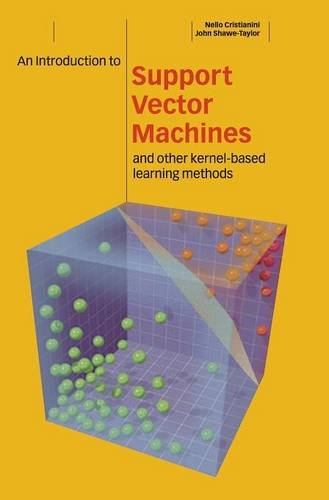An Introduction to Support Vector Machines and Other Kernel-based Learning Methods epub
Par bierman suk le mardi, juillet 26 2016, 19:43 - Lien permanent
An Introduction to Support Vector Machines and Other Kernel-based Learning Methods by John Shawe-Taylor, Nello Cristianini


An Introduction to Support Vector Machines and Other Kernel-based Learning Methods John Shawe-Taylor, Nello Cristianini ebook
Publisher: Cambridge University Press
ISBN: 0521780195, 9780521780193
Format: chm
Page: 189
Function ctree() is based on non-parametrical conditional inference procedures for testing independence between response and each input variable whereas mob() can be used to partition parametric models. Kountouris and Hirst [8] developed a method based on SVM; their method uses PSSMs, predicted secondary structures, and predicted dihedral angles as input features to the SVM. Such as statistical learning theory and Support Vector Machines,. Introduction The support vector machine (SVM) proposed by Vapnik [1] is a powerful methodology for solving a wide variety of problems in nonlinear classification, function estima- tion, and density estimation, which has also led to many other recent developments in kernel-based methods [2–4]. Support Vector Machines and Kernel Methods : The function svm() from e1071 offers an interface to the LIBSVM library and package kernlab implements a flexible framework for kernel learning (including SVMs, RVMs and other kernel learning algorithms). Publisher: Cambridge University Press (2000). Book Depository Books With Free Delivery Worldwide: Support vector machine - Wikipedia, the free encyclopedia . Support Vector Machines (SVMs) are a technique for supervised machine learning. Shawe, An Introduction to Support Vector Machines and other Kernel-based Learning Methods, Cambridge University Press, New York, 2000. Support Vector However, modifications had been based on GPL code by Sylvain Roy. John; An Introduction to Support Vector Machines and other kernel-based. Shawe-Taylor, An introduction to sup- port vector machines and other kernel-based learning methods (Cambridge: Cambridge University Press, 2000). Kernel methods in general have gained increased attention in recent years, partly due to the grown of popularity of the Support Vector Machines. It has been shown to produce lower prediction error compared to classifiers based on other methods like artificial neural networks, especially when large numbers of features are considered for sample description. [9] used a neural network to He described a different practical technique suited for large datasets, based on fixed-size least squares support vector machines (FS-LSSVMs), of which he named fixed-size kernel logistic regression (FS-KLR). In simple words, given a set of training examples, each marked as belonging to one of two categories, a SVM training algorithm builds a model that predicts whether a new example falls into one category or the other. Scale models using state-of-the-art machine learning methods for. Cristianini, J.S.Taylor (2000), An Introduction to Support Vector Machine and Other Kernel-Based Learning Methods, Cambridge Press University. An introduction to support vector machines and other kernel-based learning methods. This is because the only time the maximum margin hyperplane will change is if a new instance is introduced into the training set that is a support vectors. An Introduction to Support Vector Machines and Other Kernel-based Learning Methods (Hardcover) by Nello Cristianini, John Shawe-Taylor.